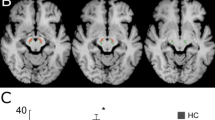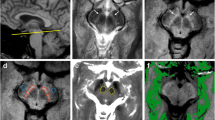Abstract
Introduction
When scanning the size of the substantia nigra (SN), for example in Parkinson's disease, it is important to precisely locate its true anatomic location. The hypointense areas on T2-weighted magnetic resonance images (T2w) at the level of the upper midbrain are usually labeled as the SN. Recent studies showed that the line of demarcation between the SN and the crus cerebri (CC) in T2w images seems not to be clear. The purpose of our study was to evaluate the depiction of the SN and the CC on calculated R2 maps by analyzing the regional distribution of T2 values in both regions.
Methods
In 36 healthy subjects, triple echo turbo spin echo were obtained at 1.5 T and R2 maps calculated. Proton density-weighted turbo spin echo images (PDw) were used as reference. The CC and SN were manually traced on PDw sections (CCP and SNP) and also the hyperintense areas on the R2 maps, suggestive of the SN (DT2). The obtained volumes were evaluated in terms of total size, intersections size, and residual areas, as well as the corresponding T2 values.
Results
DT2 corresponded to anterolateral parts of the SNP and showed an extension to anteromedial part of the CC. The intersections between DT2 and CCP and DT2 and SNP presented both decreased but different T2 values (102 ± 5 and 95 ± 4 ms).
Conclusion
An exact differentiation of the SN from the CC is not possible on the basis of T2w images but rather on the basis of the underlying calculated T2 values from the triple echo sequence.




Similar content being viewed by others
References
Crossman A (2005) Brain stem. In: Standring S (ed) Gray's anatomy: the anatomical basis of clinical practice. Churchill Livingston, Edinburgh, pp 327–351
Drayer B, Burger P, Darwin R, Riederer S, Herfkens R, Johnson GA (1986) MRI of brain iron. AJR Am J Roentgenol 147:103–110
Rutledge JN, Hilal SK, Silver AJ, Defendini R, Fahn S (1987) Study of movement disorders and brain iron by MR. AJR Am J Roentgenol 149:365–379
Haacke EM, Cheng NY, House MJ et al (2005) Imaging iron stores in the brain using magnetic resonance imaging. Magn Reson Imaging 23(1):1–25
Huber SJ, Chakeres DW, Paulson GW, Khanna R (1990) Magnetic resonance imaging in Parkinson's disease. Arch Neurol 47:735–737
Duguid JR, De La Paz R, DeGroot J (1986) Magnetic resonance imaging of the midbrain in Parkinson's disease. Ann Neurol 20:744–747
Stern MB, Braffman BH, Skolnick BE, Hurtig HI, Grossman RI (1989) Magnetic resonance imaging in Parkinson's disease and parkinsonian syndromes. Neurology. 39:1524–1526
Brass SD, Chen NK, Mulkern RV, Bakshi R (2006) Magnetic resonance imaging of iron deposition in neurological disorders. Top Magn Reson Imaging 17:31–40
Sasaki M, Shibata E, Tohyama K, Kudo K, Endoh J, Otsuka K, Sakai A (2008) Monoamine neurons in the human brain stem: anatomy, magnetic resonance imaging findings, and clinical implications. NeuroReport 19:1649–1654
Oikawa H, Sasaki M, Tamakawa Y, Ehara S, Tohyama K (2002) The substantia nigra in Parkinson disease: proton density-weighted spin echo and fast short inversion time inversion-recovery MR findings. AJNR Am J Neuroradiol 23:1747–1756
Hirsch WL, Kemp SS, Martinez AJ, Curtin H, Latchaw RE, Wolf G (1989) Anatomy of the brainstem: correlation of in vitro MR images with histologic sections. AJNR Am J Neuroradiol 10:923–928
Solsberg MD, Fournier D, Potts DG (1990) MR imaging of the excised human brainstem: a correlative neuroanatomic study. AJNR Am J Neuroradiol 11:1003–1013
Carpenter MB, Sutin J (eds) (1991) Human Neuroanatomy. Williams & Wilkins, Baltimore, pp 192-223
Lufkin R, Flannigan BD, Bentson JR, Wilson GH, Rauschning W, Hanafee W (1986) Magnetic resonance imaging of the brainstem and cranial nerves. Surg Radiol Anat 8:49–66
Gorell JM, Ordidge RJ, Brown GG, Deniau JC, Buderer NM, Helpern JA (1995) Increased iron-related MRI contrast in the substantia nigra in Parkinson's disease. Neurology 45:1138–1143
Antonini A, Leenders KL, Meier D, Oertel WH, Boesiger P, Anliker M (1993) T2 relaxation time in patients with Parkinson's disease. Neurology 43:697–700
Kosta P, Argyropoulou MI, Markoula S, Konitsiotis S (2006) MRI evaluation of the basal ganglia size and iron content in patients with Parkinson's disease. J Neurol 253:26–32
Atasoy HT, Nuyan O, Tunc T, Yorubulut M, Unal AE, Inan LE (2004) T2-weighted MRI in Parkinson's disease; substantia nigra pars compacta hypointensity correlates with the clinical scores. Neurol India 52:332–337
Vymazal J, Righini A, Brooks RA (1999) T1 and T2 in the brain of healthy subjects, patients with Parkinson's disease, and patients with multiple system atrophy: relation to iron content. Radiology 211:489–495
Bartzokis G, Cummings JL, Markham CH (1999) MRI evaluation of brain iron in earlier- and later-onset Parkinson's disease and normal subjects. Magn Reson Imaging 17:213–222
Wallis LIPM, Graham JM, Grünewald RA, Wignall EL, Joy HM, Griffith PD (2008) MRI Assessment of Basal Ganglia Iron Deposition in Parkinson's Desease. J Magn Reson Imaging 28:1061–1067
Adachi M, Hosoya T, Haku T, Yamaguchi K, Kawanami T (1999) Evaluation of the substantia nigra in patients with parkinsonian syndrome accomplished using multishot diffusion-weighted MR imaging. AJNR Am J Neuroradiol 20:1500–1506
Kitajami MKY, Kakeda S, Moriya J, Ohjnari N, Sato T, Hayashida Y, Hirai T, Okuda T, Yamashita Y (2008) Human subthalamic nucleus: evaluation with high-resolution MR imaging at 3.0 T. Neuroradiology 50:675–681
Jellinger K, Paulus W, Grundke-Iqbal I, Riederer P, Youdim MB (1990) Brain iron and ferritin in Parkinson's and Alzheimer's diseases. J Neural Transm Park Dis Dement Sect 2:327–340
Kraff O LJ, Theyson JM, Ladd ME (2009) Relaxation Time of Human Basal Ganglia Regions at 7 Tesla. Paper presented at: Proceedings of the International Society of Magnetic Resonance in Medicine, Honolulu Hawaii
Habas C, Cabanis EA (2007) Anatomical parcellation of the brainstem and cerebellar white matter: a preliminary probabilistic tractography study at 3 T. Neuroradiology 49:849–863
Conflict of interest statement
We declare that we have no conflict of interest.
Author information
Authors and Affiliations
Corresponding author
Rights and permissions
About this article
Cite this article
Mänz, C., Godau, J., Berg, D. et al. The regional distribution of T2-relaxation times in MR images of the substantia nigra and crus cerebri. Neuroradiology 52, 745–750 (2010). https://doi.org/10.1007/s00234-009-0612-x
Received:
Accepted:
Published:
Issue Date:
DOI: https://doi.org/10.1007/s00234-009-0612-x




